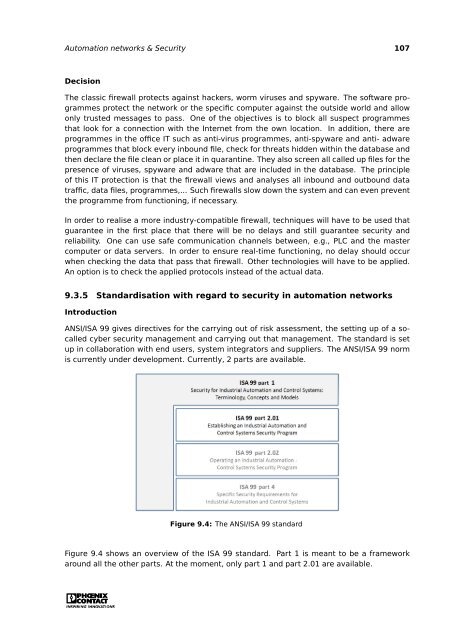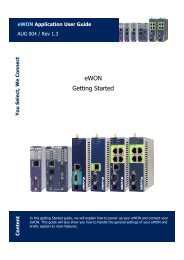Click to download Ethernet Basics manual - Grant Industrial Controls
Click to download Ethernet Basics manual - Grant Industrial Controls
Click to download Ethernet Basics manual - Grant Industrial Controls
Create successful ePaper yourself
Turn your PDF publications into a flip-book with our unique Google optimized e-Paper software.
Au<strong>to</strong>mation networks & Security 107<br />
Decision<br />
The classic firewall protects against hackers, worm viruses and spyware. The software programmes<br />
protect the network or the specific computer against the outside world and allow<br />
only trusted messages <strong>to</strong> pass. One of the objectives is <strong>to</strong> block all suspect programmes<br />
that look for a connection with the Internet from the own location. In addition, there are<br />
programmes in the office IT such as anti-virus programmes, anti-spyware and anti- adware<br />
programmes that block every inbound file, check for threats hidden within the database and<br />
then declare the file clean or place it in quarantine. They also screen all called up files for the<br />
presence of viruses, spyware and adware that are included in the database. The principle<br />
of this IT protection is that the firewall views and analyses all inbound and outbound data<br />
traffic, data files, programmes,... Such firewalls slow down the system and can even prevent<br />
the programme from functioning, if necessary.<br />
In order <strong>to</strong> realise a more industry-compatible firewall, techniques will have <strong>to</strong> be used that<br />
guarantee in the first place that there will be no delays and still guarantee security and<br />
reliability. One can use safe communication channels between, e.g., PLC and the master<br />
computer or data servers. In order <strong>to</strong> ensure real-time functioning, no delay should occur<br />
when checking the data that pass that firewall. Other technologies will have <strong>to</strong> be applied.<br />
An option is <strong>to</strong> check the applied pro<strong>to</strong>cols instead of the actual data.<br />
9.3.5 Standardisation with regard <strong>to</strong> security in au<strong>to</strong>mation networks<br />
Introduction<br />
ANSI/ISA 99 gives directives for the carrying out of risk assessment, the setting up of a socalled<br />
cyber security management and carrying out that management. The standard is set<br />
up in collaboration with end users, system integra<strong>to</strong>rs and suppliers. The ANSI/ISA 99 norm<br />
is currently under development. Currently, 2 parts are available.<br />
Figure 9.4: The ANSI/ISA 99 standard<br />
Figure 9.4 shows an overview of the ISA 99 standard. Part 1 is meant <strong>to</strong> be a framework<br />
around all the other parts. At the moment, only part 1 and part 2.01 are available.




